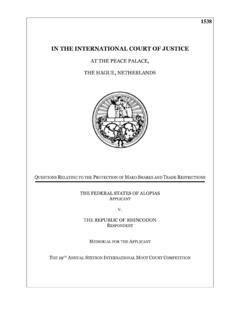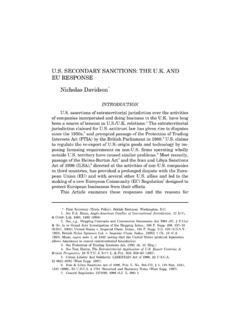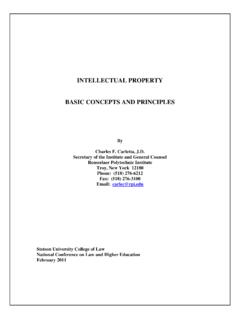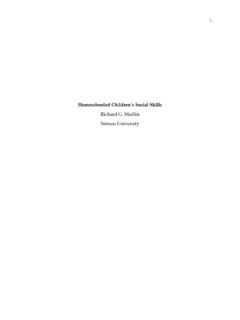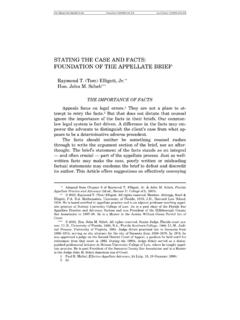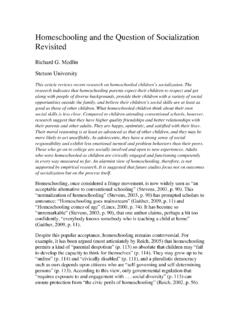Transcription of Chapter 6 - Categorical Arguments - Stetson University
1 Logic: A Brief Introduction Ronald L. Hall, Stetson University Chapter 6 - Categorical Arguments Introduction Deductive Arguments sometimes take a form called a syllogism. A syllogism is a deductive argument that is composed of three propositions. As an argument, of course, one of those propositions is used as the conclusion of the syllogism and the other two propositions are used as the premises of the syllogism. The first premise of a syllogism is called its major premise; the second premise is called the minor premise. The following is an example of such a syllogism: If I go to the movies, then I will see Jane.
2 I did go to the movies. Therefore, I saw Jane. As you might recall from earlier discussions, this argument is valid because it is a substitution instance of the valid argument form known as Modus Ponens. Remember also that there is a big difference between a existential argument and an argument form. An argument form has no specific content, while existential Arguments do. The existential argument above is about going to the movies and seeing Jane, but these references are logically irrelevant to its formal structure. The form of the argument could be expressed as follows: If p then q p Therefore q Given that this argument form is valid, any existential argument that is a substitution instance of it, like the one about Jane and the movies, is also valid.
3 As you can see, being familiar with valid argument forms is a great resource for evaluating the validity of existential Arguments . Standard Form Categorical Arguments In this Chapter we will concentrate on a existential kind of syllogism, namely, a Categorical one. We will accordingly define a Categorical syllogism as follows: Categorical Syllogism A deductive argument composed of three Categorical propositions, one of which serves as the conclusion of the argument and the other two of which serve as the major and minor premises respectively.
4 In the last Chapter , we learned that Categorical propositions have a Standard form. There are four such forms designated by the letters, A, E, I, and O. The following proposition is a Categorical proposition, but not in Standard form: No roses are not plants. However, we can translate this proposition into Standard form, since what it asserts is identical to the Standard form A Categorical proposition: All roses are plants. Had the first proposition been stated as No roses are non-plants it would have been in Standard form and more obviously the obverse of the A proposition.
5 Now we will take another step and say that the Categorical syllogism also has a standard form. There are some tests to see if a Categorical syllogism is in Standard form. 1. Each of the three Categorical propositions in the syllogism must be in Standard form. 2. The three Categorical propositions must contain only three Categorical terms: a major term, a minor term and a middle term. 3. The major term is the P-term of the conclusion and occurs only once in the major premise. 4. The minor term is the S-term of the conclusion and occurs only once in the minor premise. 5. The middle term is the class term that does not occur in the conclusion, and occurs only once in the major premise and only once in the minor premise.
6 6. The major premise is stated first, the minor premise is stated secondly, and the conclusion is stated thirdly. Consider the following Standard form Categorical syllogism: Some cats are friendly. All cats are mammals. Therefore, some mammals are friendly. In this Categorical syllogism the major term is friendly, the minor term is mammals and the middle term is cats. The first proposition here is the major premise, the second is the minor premise, and the third is the conclusion. As it so happens, this syllogism is valid. We will get to why it is presently. Consider the following Arguments .
7 Can you tell why these Categorical syllogisms are not in standard form? A. All cats are mammals. All rabbits are mammals. Therefore, all cats are rabbits. B. Some cats are not pets. Some non-pets are people. Therefore, some cats are people. C. All animals are mammals. All mammals are not endangered. Some animals are not endangered. In syllogism A, the major and minor premise are in the wrong order. The major term occurs in the major premise and is always the P-term in the conclusion. In this case, the P-term of the conclusion is rabbits.
8 However this term occurs in the second premise, which is the place of the minor premise, not the major premise. Syllogism A is not a standard form Categorical syllogism. If we changed the order of the premises it would become standard form Categorical syllogism. In syllogism B, there are more than three class terms. In this case we have four terms, pets, non-pets, cats, and people. The premises are also in the wrong order, since the major term people occurs in the second premise (the minor premise) and the minor term cats occurs in the first premise (the major premise). As well, there is not middle term, namely a single class term that occurs in both the major and the minor premise.
9 Syllogism B is not a Standard form Categorical syllogism. In syllogism C, the minor premise is not a Standard form Categorical proposition. As well, the minor and major premises are in the wrong order. Syllogism C is not a Standard form Categorical syllogism. Given these restrictions of form it should not be surprising that even though there are thousands of Categorical syllogisms there is a rather small number of possible Standard form Categorical syllogistic forms. We are careful to distinguish Categorical syllogisms from Categorical syllogistic forms. We can see this when we begin to think in terms of A, E, I, and O propositional forms.
10 There are thousands of A propositions, but only one A form. And the same is true for the other three propositional forms, E, I, and O. Accordingly, a syllogistic form is partially expressed as a combination of three of these propositional forms, and would look something like, AEI, or AAA, or EIO, or some other of the possible combinations. This formal order of letters is called the mood of the syllogism. There are only 64 different Standard form Categorical syllogistic moods. We cannot say, however, that there are only 64 Standard form Categorical syllogistic forms. The reason for this is that there are variations in the place that the middle term can occupy in a standard form Categorical syllogism.
